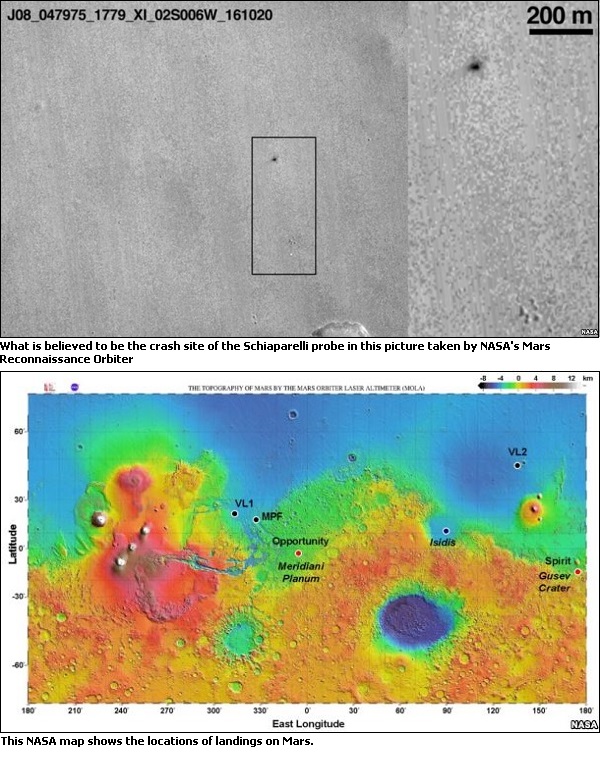
|
|

|
|
| April 20, 2024 |
|
Europe's Mars spacecraft hit planet at race car speed 
A NASA spacecraft has spotted a new black crater on Mars — the final resting spot of Europe’s Schiaparelli lander, which apparently slammed into the Martian surface at race car speed and may have exploded on impact.
The low-resolution camera on NASA’s Mars Reconnaissance Orbiter was supposed to snap pictures of Schiaparelli after a successful touchdown Wednesday. Instead, the camera captured a dark patch roughly 16 by 45 yards and, just over half a mile away, a bright spot that is probably the remains of the lander’s enormous parachute, the European Space Agency said Friday. If all had gone as planned, Schiaparelli would’ve ridden much of the way to the Martian surface on its parachute, which would have then dropped away to expose nine rockets. The firing of the rockets would’ve slowed the spacecraft before cutting off 6 or 7 feet above the surface, leaving Schiaparelli to free-fall to the Martian soil and land at a gentle 5 mph or so. But the rockets “switched off prematurely,” according to a statement Friday from the European Space Agency, which operated Schiaparelli, and the lander made “a much longer free fall than planned,” resulting in a speed on impact of more than 185 mph — as fast as a Formula One car. Because the rockets turned off early, much of their fuel was still onboard when the spacecraft shattered in the red dust of Mars, making it “possible” that the lander “exploded on impact,” the agency said. If there was any saving grace in the news, it was that engineers and scientists have been spared a long period of anxiety and suspense. After mission controllers lost touch with Britain’s Beagle 2 on its way to Mars in 2003, it was another 11 years before Mars Reconnaissance Orbiter photographed the lander’s remains on the Red Planet’s surface. The loss of Schiaparelli was also counterbalanced by the resounding success of Europe’s Trace Gas Orbiter, which launched together with the lander and is now safely in orbit around Mars. Europe now has two spacecraft in orbit around the planet, no small achievement given humankind’s abysmal record of sending craft to Mars. Roughly half of the 50-plus spacecraft sent to land on or orbit Mars have met untimely ends, Schiaparelli now among them. Landers have crashed into the surface, burned up in the atmosphere, or missed Mars entirely. Only seven landers — all built and operated by NASA — have survived the perilous trip with faculties intact. Schiaparelli was designed to test technologies for a much larger roving laboratory scheduled for launch in 2020. Its demise puts the timing and design of that mission in doubt. Engineers hope to learn more from images that will be taken in coming days by the high-resolution camera on Mars Reconnaissance Orbiter. Engineers also continue to study data transmitted from Schiaparelli to Earth, which should allow them to determine exactly what went wrong. (Source: USA Today) Story Date: October 23, 2016
|